HISTORY OF PASCO COUNTYGerman POW’s in Dade CityA Ray of Sunlight in the Clouds of WarBy J. W. HUNNICUTT In 1936, as the country was recovering from the Great Depression, a group of entrepreneurial growers led by LaMarcus Edwards, Herbert Massey and Franklin Price formed Pasco Packing Association, a fresh fruit cooperative destined to become the leader of the Florida citrus industry. At its peak Pasco Packing had more than 2000 workers and was considered the largest single citrus processing plant in the world and the driving economic force in Dade City. From its earliest days, the company grew by challenging the future. It was among the first to begin canning single strength juices, winning an award from the War Food Administration for its massive production of citrus juices distributed to our soldiers during WW II. In the late 1940’s in conjunction with the Florida Citrus Commission, Pasco shaped the history of the industry by pioneering frozen concentrated orange juice. During 1944-1946 over 200 German POW’s worked at the plant, primarily in construction. The prisoners were German soldiers who were in Rommel’s Afrika Korps and were captured in North Africa. They lived in a small tent area near downtown Dade City. The best-known prisoner was an artist, Heinz Friedmann. He painted a large aerial-view mural of the citrus plant buildings, water towers and surrounding orange grove operations on the walls of one of the executive offices. On April 14, 1944 the Florida Times Union reported: “A unit of 250 German prisoners arrived on a special train this week from a camp in Augusta, Ga. And have been moved into the camp on the eastern edge of Dade City. Buildings to house the prisoners and the force of sixty military police have been built under the direction of Army engineers. The military personnel of the camp are permitted to live off the reservation when not on duty and many of them have been joined here by their families and have taken apartments in Dade City. The prisoners were brought here to work at the plant of the Pasco Packing association and the mill at Lacoochee, operated by Cummer Sons Cypress Co. Most of the prisoners are young and groups of them in the camp last evening were singing. An officer remarked that they would no doubt soon be singing ‘God Bless America,’ as they seem rather content to be here.” In 1958 Pasco Packing Association’s name was changed to Lykes Pasco Packing, Inc. Longtime Lykes Pasco employees recall that the company brought Heinz Friedmann back to Dade City from Germany in 1986 to participate in activities related to celebrating their 50th anniversary. A Site of WW II Prisoner of War Camp Marker has been erected on Martin Luther King Blvd in Dade City 0.1 miles east of U.S. 98, an area now known as Naomi Jones Pyracantha Park. Lykes Pasco closed in 2004 and the property has now been developed into a business park, Dade City Business Center/Dade City Office Plaza. The current owners have preserved the mural. 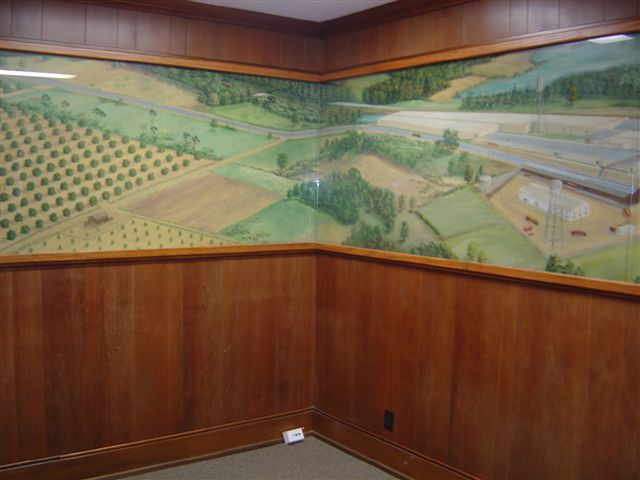 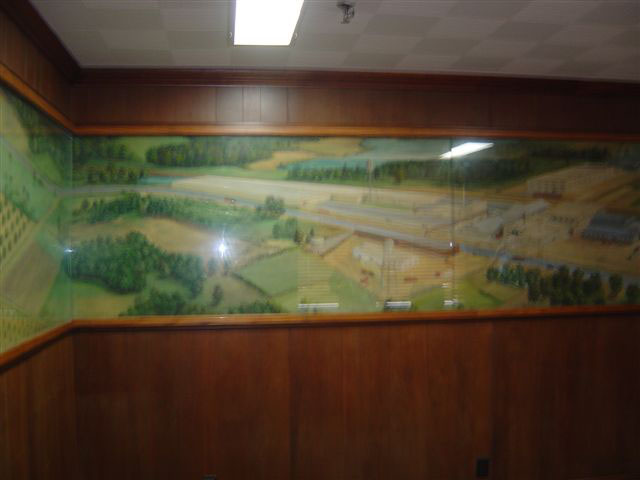 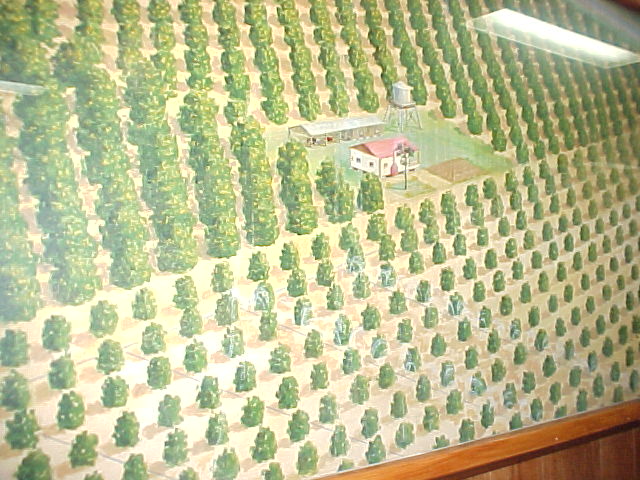 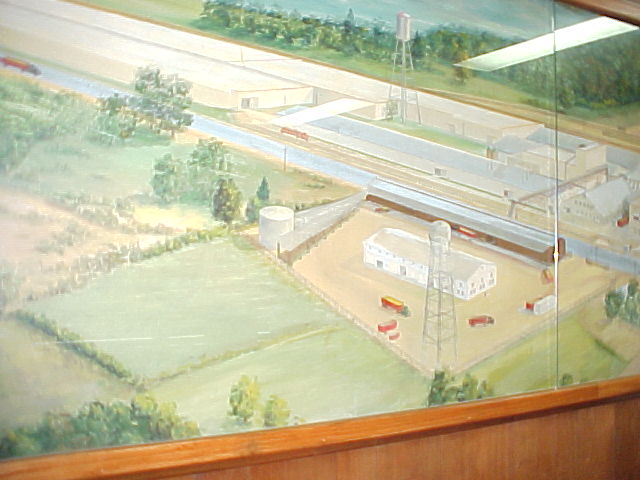 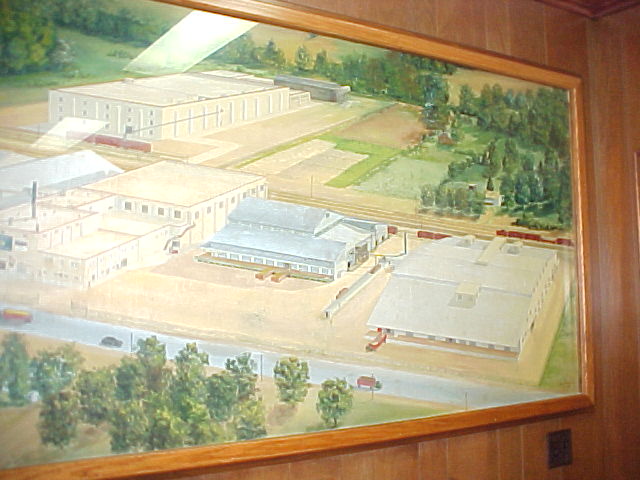 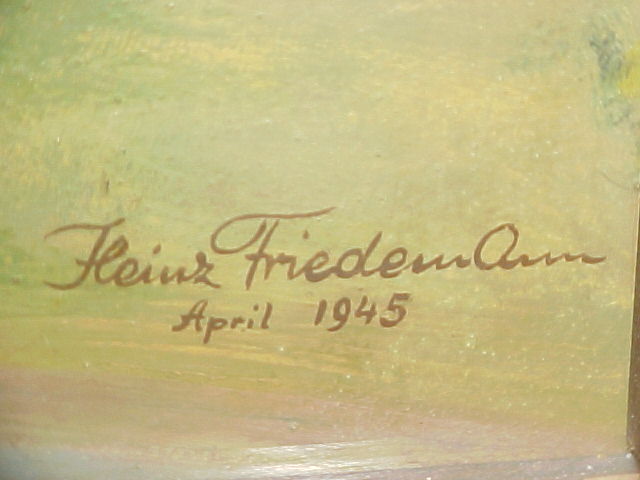 We express our appreciation to Robert C. Van Allen, General Manager, Dade City Office Plaza, for his help in developing this story and for allowing us access to the mural for photographs. Thanks to J. W. Hunnicutt and Paul Prine for providing the pictures of the mural. WWII POWs Treated Well At Dade City Prison CampBy CAROL JEFFARES HEDMAN This article appeared in the Tampa Tribune on Dec. 17, 2004. DADE CITY – For two years during World War II, a prisoner of war camp near downtown Dade City housed about 250 German soldiers. The camp, known as Company 7, was a branch of Camp Blanding. It was established in March 1944 and was square- shaped, with wooden watchtowers and searchlights at the corners. The prisoners lived in four-man tents. A wooden barracks housed washrooms, a kitchen and a mess hall. Two barbed-wire fences surrounded the camp. As with other POW camps, the Dade City facility was established to subsidize the work force that had been depleted by local workers going to war. Many prisoners worked at Pasco Packing Association, a citrus processing plant. Others worked at the Cummer Sons Cypress Co. sawmill and box factory in Lacoochee and at the McDonald mine near Brooksville making limestone bricks. For their work, prisoners received 80 cents a day in stamps and ration cards, which they could use to purchase personal items at the camp. Treatment of local POWs was better than what was mandated in the Geneva Convention, signed in 1929 by 47 countries, including Germany and the United States. Several former POWs imprisoned in Dade City returned after the war to find those who had treated them kindly. “They were my friends,” said Bill Cox, a Dade City resident who was a supervisor at Cummer Sons Cypress Co. when the POWs worked there. “They were like family.” On Sundays, the Americans would take the prisoners to the picture show, and they would all have popcorn. “In your mind, you cannot visualize the care that the people in the community gave to those prisoners,” Cox said. “They wanted for nothing.” Cox does remember a day, however, when the workers decided to strike. It was a Wednesday night, and the rules of the Geneva Convention mandated only that prisoners be given bread and water. When the prisoners struck, Cox said, the group was served bread and water for dinner that night and breakfast the next day. They were told they could have “all the bread and water you want three times a day,” Cox said, “and by Friday they were ready to go to work.” German-born Abbot Francis Sadlier, of Saint Leo Abbey, assisted by the Rev. Gregory Traeger, conducted religious services at the camp and hosted about 500 POWs from camps across Florida at Christmas and Easter celebrations at the Abbey Church. Traeger and Cox, along with east Pasco residents Phyllis Smith, William Dayton and Charles Arnade, reminisce about the POWs in Dade City on a video included in a special exhibit at the Florida Holocaust Museum in St. Petersburg. The exhibit, “Humanity Through Barbed Wire,” runs through Jan. 9. The memories are about all that is left of the POW camp in Dade City. The old barracks, built by the U.S. Army Corps of Engineers, was torn down in the late 1980s. A mural painted by a POW on the wall of Pasco Packing Association remains, although few have seen the work. Heinz Friedman painted it for the office of then-President L.C. “Mark” Edwards Jr. It features an aerial view of the plant and surrounding countryside. Edwards received several letters from Friedman after the war. One was a pattern of Friedman’s fiancee’s feet, according to Louise Edwards, whose late husband, Bill Edwards, succeeded his brother at the plant. In postwar Germany, shoes were scarce. Friedman wrote to Mark Edwards seeking a pair for his bride-to-be to wear on their wedding day, Louise Edwards said. He obliged, but to her knowledge that was the last time he heard from Friedman. Edwards would like the mural to be preserved, perhaps by the Pioneer Florida Museum and Village, to mark the era when the German prisoners of war worked at Pasco Packing Association. The POW camp in Dade City closed in the spring of 1945. German POW Recalls Woman’s AidBy CAROL JEFFARES HEDMAN This article appeared in the Tampa Tribune on Dec. 25, 2004. A historical marker stands in Dade City at the site where 250 prisoners of war were held during World War II. The prisoners had been treated kindly, and several returned to Dade City in later years to look for those who befriended them. Arthur Lang, of Ommersheim, Germany, returned in 1986 in an unsuccessful search for a woman who showed him kindness while he worked at the box factory of Cummer Sons Cypress Co. in Lacoochee. Lang was 18 when he enlisted in the German army as a tank driver. A year later, in 1944, he was sent to the French front. Lang was active in the Allied invasion, started on June 6, 1944, an experience he long had dreaded, he wrote to a Tampa Tribune reporter of his recollections of the war. “It was a very hard fight. The American and English troops had landed in Normandy with a very large air support and materials, manpower and weaponry that was definitely superior to what we had. We could not withstand them for long.” Lang was among the soldiers captured by Americans. The prisoners were held in England before crossing the Atlantic in a ship bringing American troops home. En route to Boston, the ship dodged German submarines, Lang wrote of his wartime experience. The prisoners traveled by train to Camp Blanding, near Starke. From there, he and others were assigned to Dade City, arriving Aug. 14, 1944. “I cannot tell you what it is for a young person to be behind barbed wire for a length of time,” Lang wrote of his stay. “You just have to imagine and see how you feel.” In December 1944, Lang was taken to Camp Blanding for an infection in a back muscle, returned to Dade City and put on light work at the Lacoochee sawmill box factory. While a prisoner, Lang earned educational certificates in English and American history. After the war ended in 1945, security at the POW camp was increased and the food supply plummeted. The prisoners were hungry, Lang wrote. Friends the prisoners had made supported them, and brought food when they saw they were hungry. One of those who gave Lang food and “the will to carry on” was a young woman, about his age, who worked at the box factory with her mother. “I regret it to this day that on the last day there, I could not shake her hand, tell her ‘Danke’ and ‘Auf widersehen,’ ” Lang wrote. The two had never spoken. They communicated with scribbled notes, passing to each other when no one was watching. In March 1946, Lang returned to Germany. About a year after he left Dade City, he wrote to the young woman, but she did not reply. Another former POW, Hermann Boettjer, returned to Dade City in 1993. Boettjer was injured while fighting in Russia and shipped home to recuperate before being sent to join Erwin Rommel’s Afrika Korps in Tunisia, he told a translator for a Tampa Tribune story during his Dade City visit. Boettjer was captured by the British in Tunisia on April 10, 1943, and processed Nov. 29, 1943, at Camp Gordon in Augusta, Ga. From there, he was sent to Camp Blanding, then to Leesburg and Dade City. Boettjer picked fruit and helped build warehouses at Pasco Packing Association. During his return visit, he met with the Rev. Gregory Traeger, a priest at Saint Leo Abbey who assisted at Mass for the POWs. Boettjer also visited the abbey’s peace memorial statue and sang a tribute in German to the soldiers who died during the war. About half a dozen former POWs have returned, according to research Eva Martha Knapp found during a project her 10th-grade class conducted in 1992. Ludeke Herder is one of those and wrote to Knapp’s class of the kindness he experienced while a POW. He recalled attending a Protestant church service on Christmas Day at a Lutheran church in Tampa. The guards attended the service – without guns – with the prisoners. Herder wrote that the prisoners were told to leave by a side door. When they emerged, a crowd showered the men with cakes, candy and coffee. It was a “wonderful Christmas Day,” he wrote. “I never can forget such a kind gesture.” The parish also collected books for the prisoners, most of them in German. |
